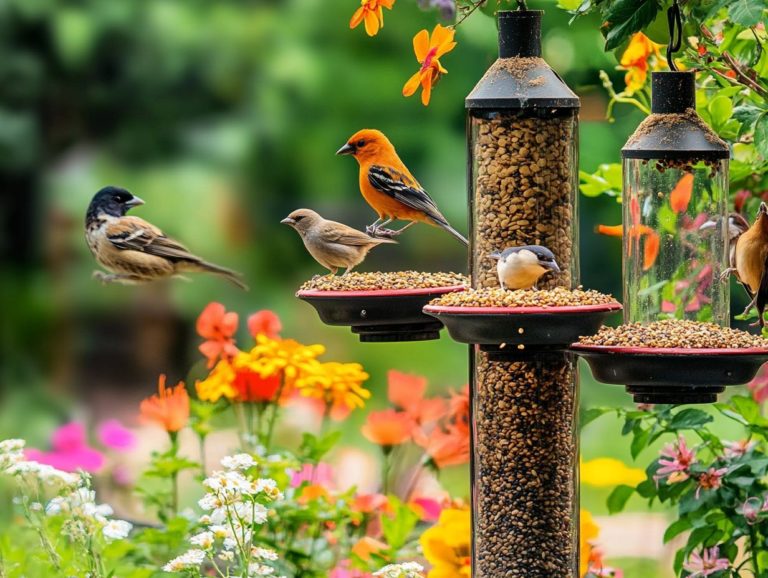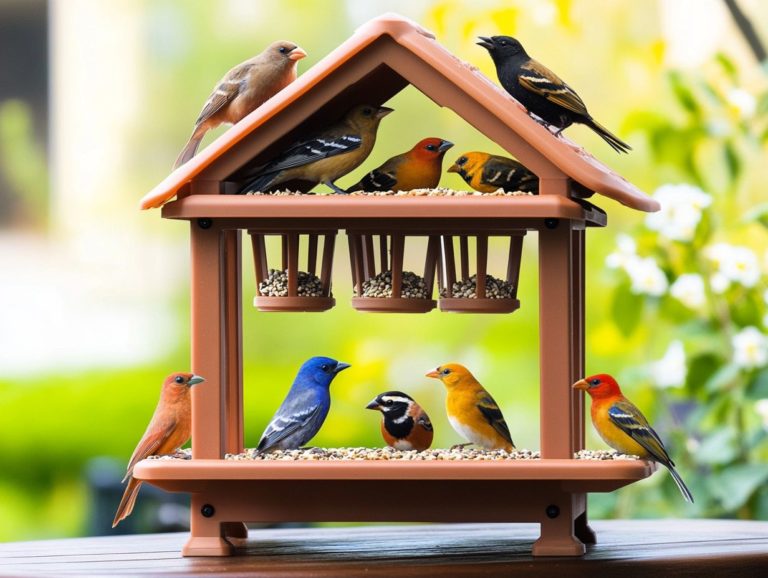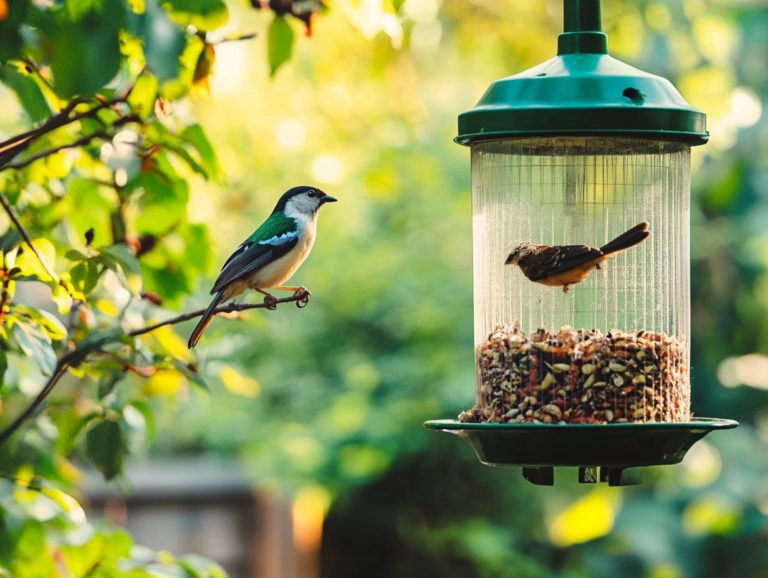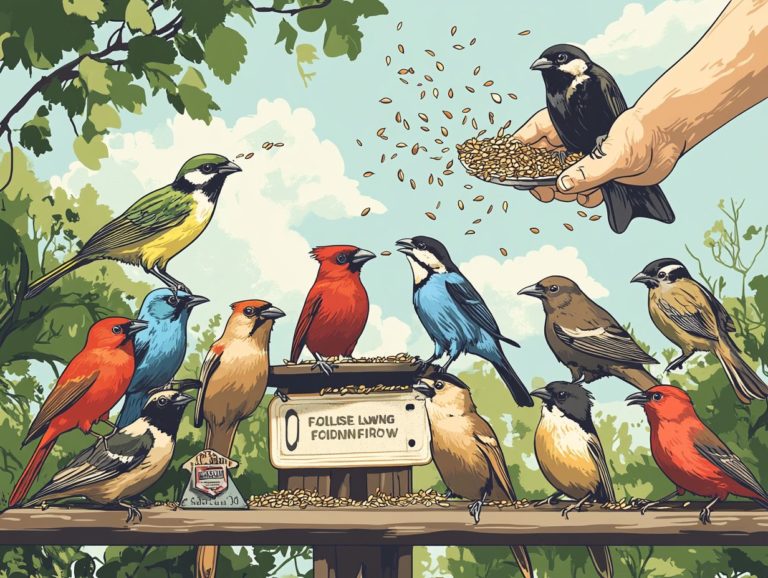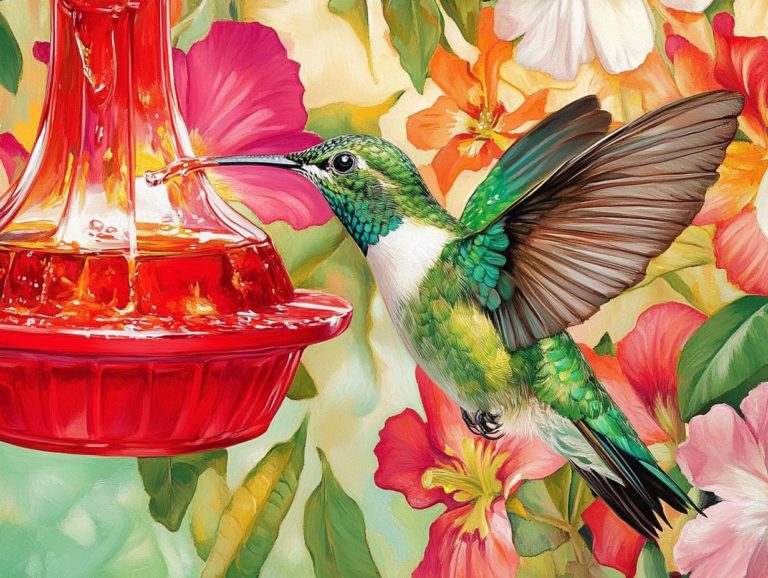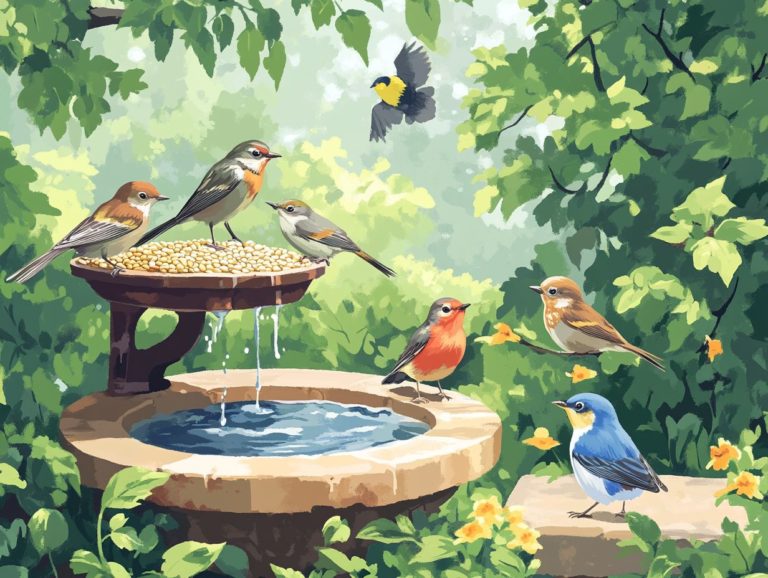Best Practices for Bird Feeder Placement
Bird feeder placement can significantly impact your success in attracting a diverse array of feathered friends to your backyard.
To optimize your setup, consider the types of birds that frequent your area and the design of your feeder. It s equally important to be aware of common pitfalls to avoid, ensuring that your feeding station remains safe and accessible for its avian visitors.
By adhering to best practices, you can cultivate an inviting environment for birds, creating a lively atmosphere in your backyard.
Contents
- Key Takeaways:
- Why is Placement Important?
- Factors to Consider
- Common Placement Mistakes
- Top Tips for Bird Feeder Placement
- Frequently Asked Questions
- What are the best practices for bird feeder placement?
- Why is it important to choose a safe location for a bird feeder?
- How often should I clean my bird feeder?
- What types of food should I offer in my bird feeder?
- Should I place my bird feeder near my house or in a more secluded area?
- How can I prevent squirrels from accessing my bird feeder?
Key Takeaways:
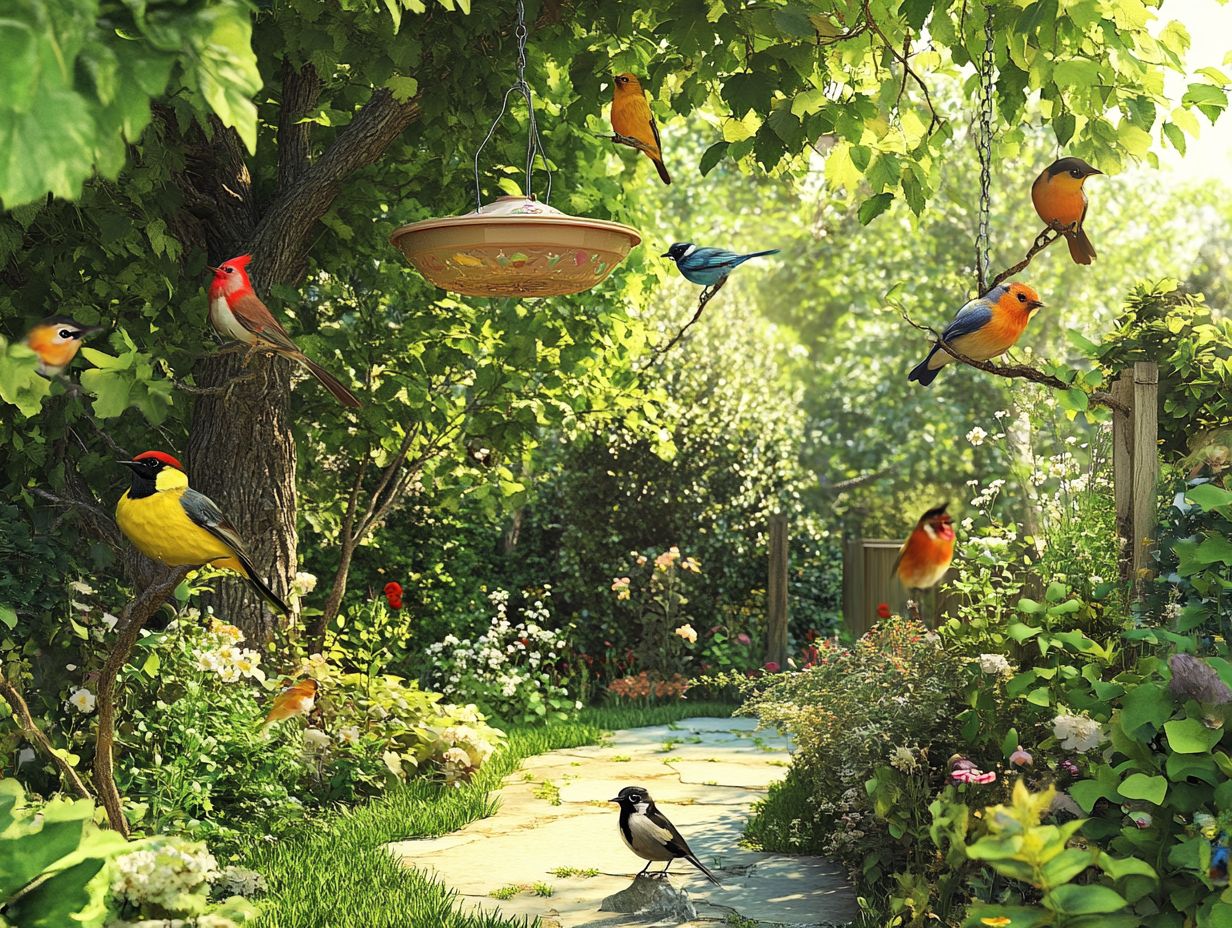
- Consider the types of birds in your area: Different species of birds, including hummingbirds and goldfinches, have different feeding preferences and habits. Research the types of birds in your area and choose a feeder placement that will attract them.
- Avoid predators and hazards: Be mindful of potential dangers, such as predators and hazardous areas, when choosing a location for your bird feeder. This will help protect the birds and ensure they feel safe while feeding.
- Recommended heights and locations: To attract a diverse range of bird species, place feeders at varying heights and in different locations, such as near trees and bushes, to provide shelter and a sense of natural habitat.
Why is Placement Important?
Placement is important when it comes to attracting a diverse array of wildlife, especially backyard birds. It plays a key role in their feeding habits, safety from predators, and overall enjoyment of bird watching.
By positioning your feeders thoughtfully, you can boost bird populations and support their migration patterns, turning your garden into a vibrant sanctuary for various species, including songbirds, with each passing season.
By understanding the key factors that influence how birds engage with your feeders, you will create a more fulfilling bird watching experience for yourself while providing a safe haven for the birds.
Factors to Consider
When you set up a bird feeding station, think about several key factors to ensure a successful feeding routine that attracts a variety of birds while prioritizing their health and safety, including the quality of birdseed.
Consider the types of bird feeders you use, the quality of the bird foods you offer, and the surrounding environment especially the presence of native plants that provide additional food, nesting materials, and shelter.
Being mindful of potential rodent attractants and bird diseases is crucial for maintaining a safe habitat for both the birds and the local wildlife.
Types of Birds in Your Area
Understanding the types of birds in your area is crucial for crafting effective bird feeding strategies that attract specific species like hummingbirds, goldfinches, and woodpeckers. Each bird species has unique dietary preferences and behaviors that shape their feeding habits, making it essential to provide a diverse array of bird foods and feeder types to accommodate them.
By identifying local species such as mourning doves, cardinals, and jays, you can establish targeted feeding stations that enhance your bird watching experience and support a rich variety of avian populations, including woodpeckers and robins.
For instance, offering black-oil sunflower seeds can draw in a wide range of birds, thanks to their high-fat content an essential energy source, particularly during the chillier months. Nyjer seeds, loved by small finches, can attract goldfinches and other petite birds, especially when served in specialized feeders designed to keep larger birds at bay.
Different feeder types, like tube feeders, platform feeders, and suet holders, cater to varied feeding styles. Tube feeders are perfect for clinging birds, while platform feeders welcome ground feeders like doves and jays. This ensures that every bird has a suitable dining option, including finches.
Start setting up your bird feeders today and enjoy the vibrant wildlife in your backyard!
Feeder Design and Accessibility
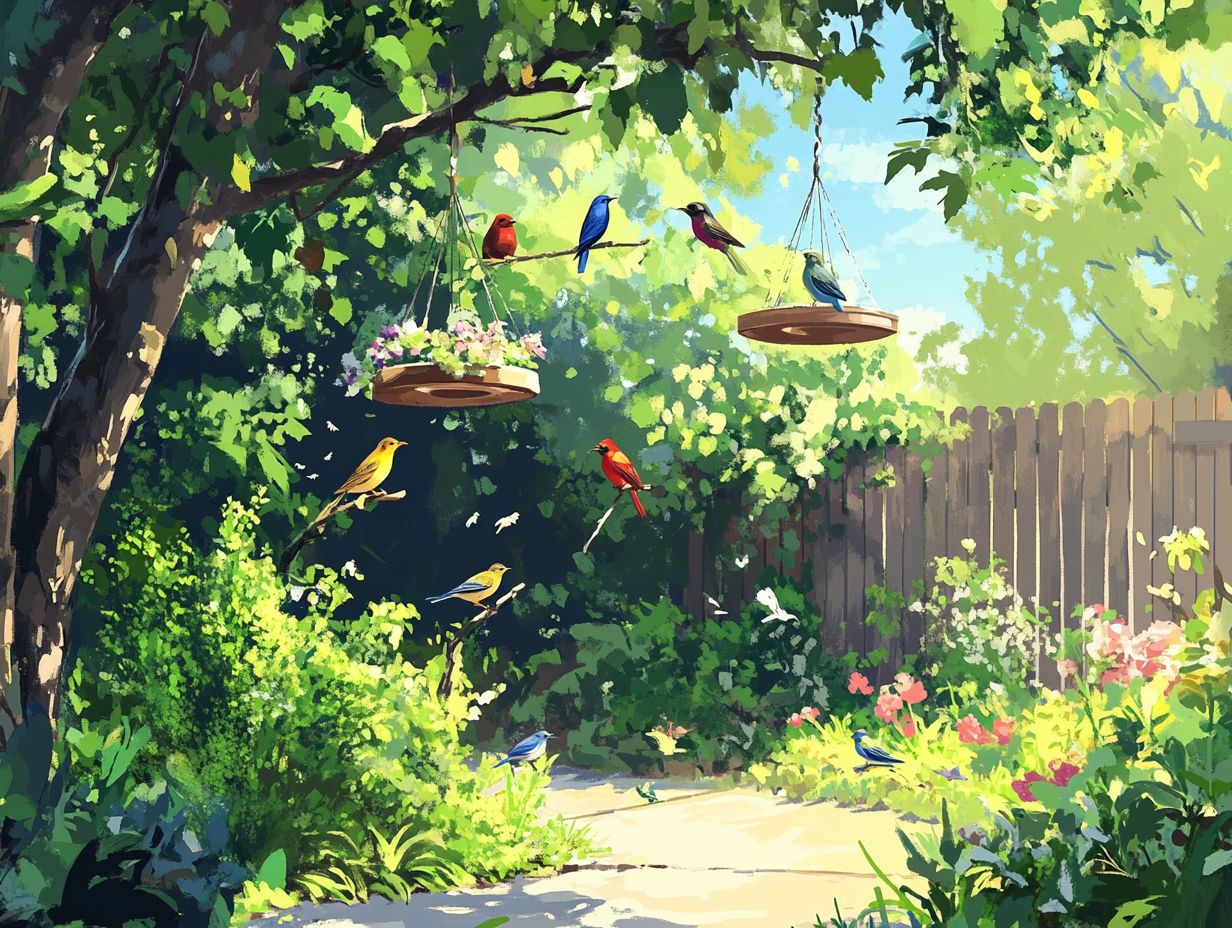
The design and accessibility of bird feeders are essential for attracting birds and ensuring they can easily access the food you provide. Different types of feeders like tube feeders, platform feeders, and suet cakes cater to various species and their unique feeding habits.
Consider feeder heights to maximize the bird population in your backyard. For tips on setting up your space effectively, check out how to attract more birds with feeders. Make sure feeders remain accessible while also being safe from outdoor cats.
If you set up elevated tube feeders, you ll effectively attract smaller birds like finches and chickadees. On the other hand, platform feeders are perfect for larger species such as doves and jays.
Don t forget about suet feeders; when hung from branches, they ll draw in woodpeckers and nuthatches that thrive on those high-fat offerings during the cold months.
Maintaining a regular cleaning routine is vital, as it helps prevent avian diseases that can thrive in leftover food residue. Ideally, position your feeders at least five feet off the ground and away from dense shrubbery to enhance visibility for the birds.
This distance also keeps them safe from potential predators.
Environmental Factors
Environmental factors play a crucial role in shaping bird feeding habits. This includes the availability of natural food sources, water, and safe cover provided by native plants.
By creating a habitat filled with bird-friendly plants, you attract a variety of species and provide essential nesting materials and shelter. Understand the impact of seasonal changes like the differences between winter and summer feeding to adjust your feeding routine.
During colder months, birds rely more heavily on your feeders as natural food becomes scarce. A consistent supply of seeds is absolutely vital.
In contrast, come spring and summer, when insects and berries are abundant, birds might prefer foraging naturally.
Since not all bird species have the same preferences, diversifying your offerings such as including suet or fruit can cater to a broader range of avian visitors.
Ensure clean water sources are available year-round. This greatly influences birds hydration and bathing habits, fostering a variety of plant and animal life in your garden.
Common Placement Mistakes
Many bird enthusiasts make common placement mistakes that can undermine their efforts in attracting birds. These mistakes may even compromise their safety, leading to increased instances of bird collisions.
Examples include placing feeders too close to windows or near areas with lots of cats. When feeders are incorrectly placed, they can lead to unfortunate collisions, expose birds to lurking outdoor cats, and create unnecessary conflicts with local wildlife.
Being aware of these pitfalls can help you create a safe haven for birds in your backyard.
Avoiding Predators and Hazards
To successfully attract and retain delightful backyard birds, it s crucial to minimize risks from predators and reduce hazards like bird collisions with windows. Place your feeders in locations with ample safe cover and away from potential threats.
This proactive approach enhances your chances of attracting a variety of species and supports their overall health and well-being.
Incorporating elements like shrubs, trees, or specially designed birdhouses provides essential shelter from predators and harsh weather conditions.
Using protective features, such as plastic domes, helps shield feeders from larger birds while granting smaller species easy access to food.
Position feeders at the right height and distance from windows to further reduce the likelihood of collisions. For more insights, check out choosing the right bird feeder for your area. These thoughtful strategies cultivate an inviting habitat.
Act now to make your backyard a safe haven that attracts a variety of birds and supports their health!
Proximity to Windows and Other Structures
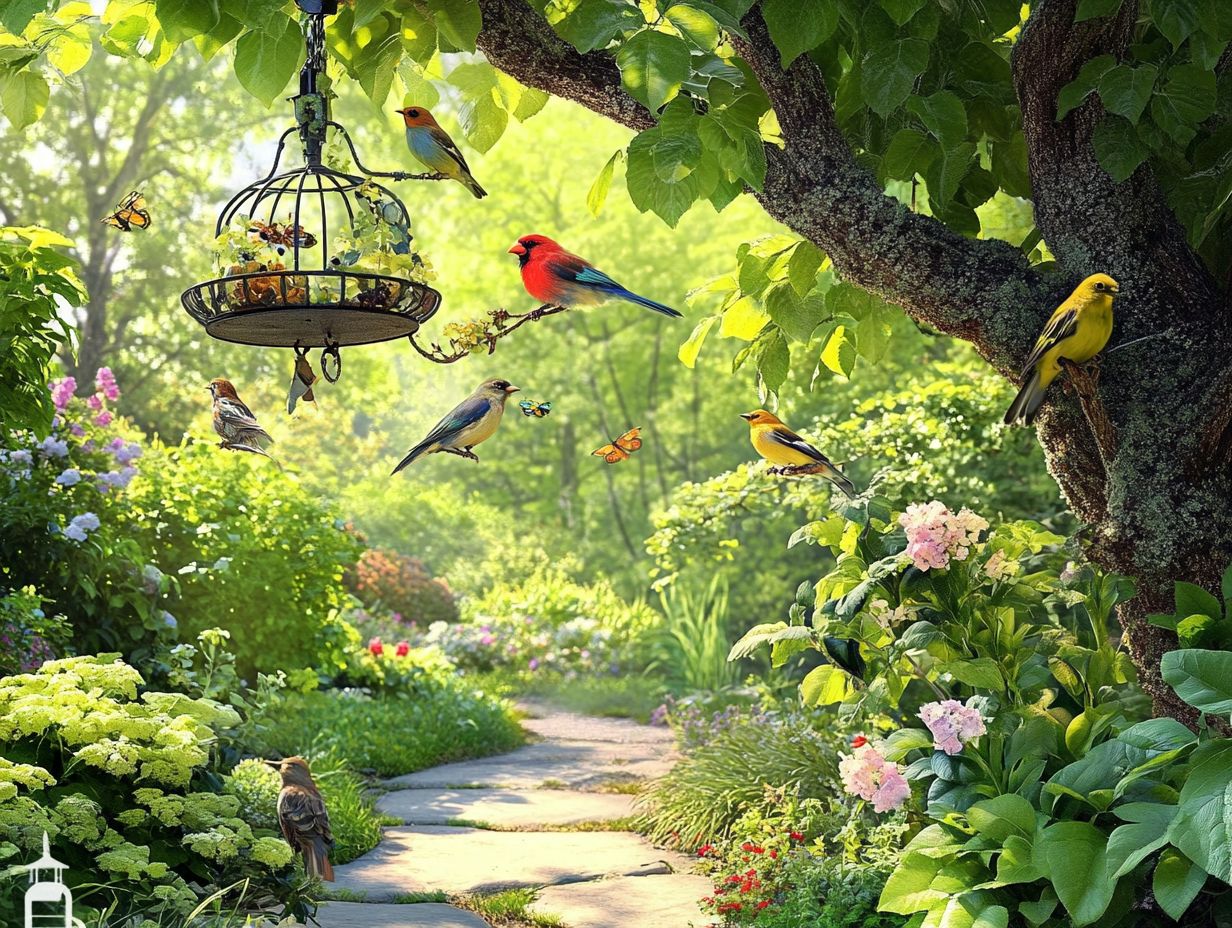
The placement of bird feeders in relation to windows and other structures is crucial for preventing bird collisions. These collisions can pose serious risks to local bird populations. When feeders are positioned too close to glass surfaces, birds may accidentally fly into them, which can lead to injuries or even fatalities.
To address this concern, strategically position your feeders at a safe distance from windows while still creating an inviting feeding area for your feathered friends. This reduces the chances of bird collisions.
Ideally, place feeders at least three feet away from any glass surface to significantly lessen the likelihood of collisions. Birds navigate much more effectively at this distance. Choosing feeders designed to enhance visibility from multiple angles can further promote bird safety, and utilizing essential tools for bird feeder setup can help ensure their effectiveness. Alternatively, situate feeders near shrubs or trees to provide a natural refuge for birds, minimizing their risk of accidents.
By taking these precautions, you cultivate a safer feeding environment and contribute to the preservation of vibrant bird populations in your area. This helps foster a more humane backyard!
Top Tips for Bird Feeder Placement
Implementing best practices for feeder placement is essential for maximizing the attraction and safety of backyard birds. For more insights, consider understanding bird feeder preferences. This ensures you have an enriching birdwatching experience while providing an adequate water source, like bird baths.
By considering recommended heights, strategic locations, and accessibility, you can create an inviting environment that accommodates various species and fosters healthy bird populations.
Effective placement helps birds feel secure while dining and enhances the aesthetic charm of your backyard sanctuary, making it a prime spot for bird feeding!
Recommended Heights and Locations
Understanding the ideal heights and locations for your bird feeders is crucial for attracting a diverse array of bird species. Each species has its preferences. For example, hummingbirds thrive at lower placements, while larger birds like jays prefer feeders positioned higher up.
By strategically placing your feeders in optimal spots, you cater to various species and elevate their feeding experience right in your backyard, especially when you follow some top bird feeding tips for beginners!
Consider the surrounding environment carefully when deciding where to set up your feeders. As a birdwatcher, pay attention to the local flora. Species such as finches are often more visible near bird-friendly plants that provide natural cover.
Position your feeders away from potential threats like windows and lurking outdoor cats to ensure that all visiting birds feel safe and secure. Observing the sun’s path can guide you; placing feeders in areas that receive early morning light can lead to increased activity. Additionally, consider implementing quick fixes for common bird feeder problems to transform your backyard into an inviting sanctuary for a wider range of feathered friends!
Tips for Attracting Different Bird Species
Attracting a variety of bird species to your backyard demands a thoughtful strategy that blends the right bird foods, feeder types, and environmental enhancements. By diversifying your feeding routine and incorporating bird-friendly plants, you can craft a welcoming habitat that lures in an array of birds from vibrant goldfinches to elusive woodpeckers!
Understanding the seasonal shifts in feeding habits is essential. Many birds crave high-fat foods during winter to fuel their energy needs. In spring, offering nesting materials can entice a broader spectrum of species.
To cater to varying preferences, consider an assortment of feeders like tube feeders for small seeds, platform feeders for larger ones, and suet feeders for insect-eating birds. Adding water features or native plants will cultivate a harmonious environment that attracts even more species, providing you with a dynamic display of nature’s beauty all year round!
Frequently Asked Questions
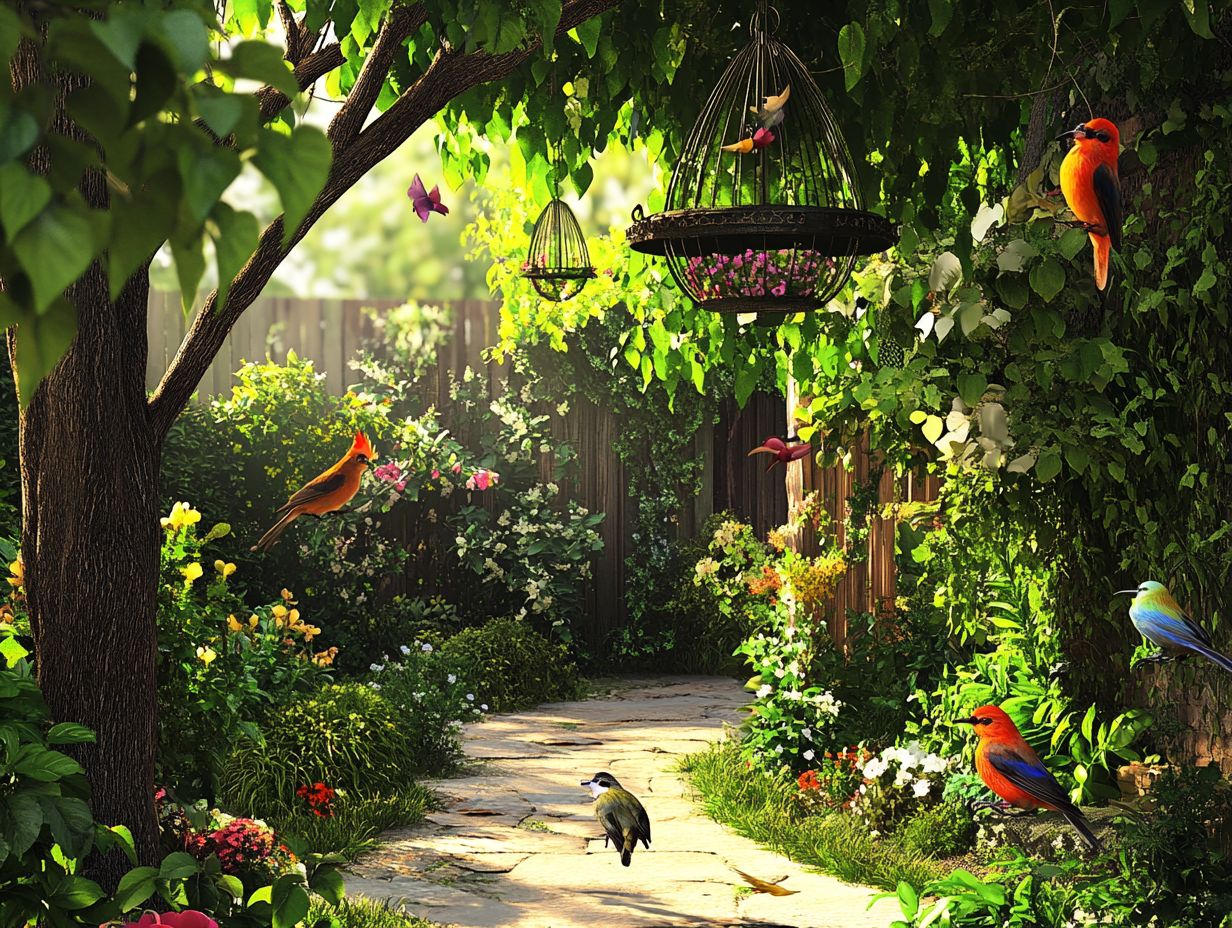
What are the best practices for bird feeder placement?
Choose a safe and accessible location for your bird feeder. Regularly clean it and provide a variety of food options to attract different bird species.
Why is it important to choose a safe location for a bird feeder?
A safe location helps protect birds from predators. It also keeps the feeder away from high-traffic areas to reduce stress for the birds.
How often should I clean my bird feeder?
Clean your bird feeder at least once a week to prevent bacteria and diseases. If it becomes wet or moldy, clean it immediately!
What types of food should I offer in my bird feeder?
Offer a variety of food options such as seeds, suet, and nectar to attract many bird species. Use high-quality food to ensure proper nutrition for the birds!
Should I place my bird feeder near my house or in a more secluded area?
Place bird feeders at least 10-15 feet away from your house to avoid collisions with windows. Secluded areas can also attract shy or less common bird species.
How can I prevent squirrels from accessing my bird feeder?
Use squirrel-proof feeders or place the feeder on a pole with a baffle a device that keeps squirrels from climbing up to it. You can also distract squirrels by offering them food in a separate feeder!

